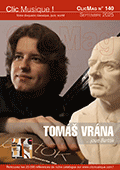|
|

Diapason from July 2024
Review de Bertrand Hainaut
Page No. 82

Classica from October 2024
Review de Gérard Belvire
Page No. 90
Format : 1 CD
Total Time : 00:50:29
Recording : 10-12/04/2006
Location : Salzbourg
Country : Autriche
Sound : Stereo
Label : Gramola
Catalog No. : GRAM99287
EAN : 9003643992870
Price Code : DM020A
Publishing Year : 2024
Release Date : 06/03/2024
Genre : Classical
|
|
 |
Wolfgang Amadeus Mozart (1756-1791)
Concerto pour cor en ré majeur, K 412 (386 b)
Concerto pour cor en mi bémol majeur, K 417
Concerto pour cor en mi bémol majeur, K 447
Concerto pour cor en mi bémol majeur, K 495
Hansjörg Angerer, cor naturel
Salzburger Hofmusik
Wolfgang Brunner, direction
|
 
|
Gramola réédite un enregistrement daté de 2006 (le 250e anniversaire de la naissance de Mozart) des quatre concertos pour cor du Salzbourgeois. C’est d’ailleurs un ensemble de la ville natale de Mozart – la Salzburger Hofmusik – qui officie ici, avec en soliste Hansjörg Angerer. Celui a qui successivement enseigné au Mozarteum de Salzbourg et à Nuremberg joue un cor naturel fabriqué en 1800 par un facteur bohémien. Si la discographie n’était déjà riche de plusieurs versions de référence de ces œuvres écrites par Mozart pour son ami d’enfance Joseph Leutgeb, on pourrait prêter intérêt à ce disque plutôt court de minutage comme d’inspiration. La difficulté du cor naturel est sûrement à l’origine de la prudence de l’interprète, mais l’accompagnement sans allant et sans allure de l’orchestre, alliés à un enregistrement peu flatteur, ne l’aident pas. (Jean-Pierre Rousseau)  The horn concertos by Wolfgang Amadeus Mozart have always been part of the standard repertoire of every horn player. Tyrolean hornist Hansjörg Angerer presents the four horn concertos with the Ensemble Salzburger Hofmusik under the direction of Wolfgang Brunner on an original instrument by an unknown Bohemian master from around 1800. The natural horn originated from the hunting horn by combining the windings, whereby the natural tone series could be played in all common keys by placing different tuning bows on it and, in addition, the intermediate tones of the natural tone series could be obtained, and the sharp or flat tones could be regulated by inserting the right hand into the falls by “plugging” and “damping”. The complex playing techniques as well as the characteristic sound differ fundamentally from a modern valve instrument and allow a deep dive into the great variety of colors in the music of this era.
|
| . |
 |
|
|
